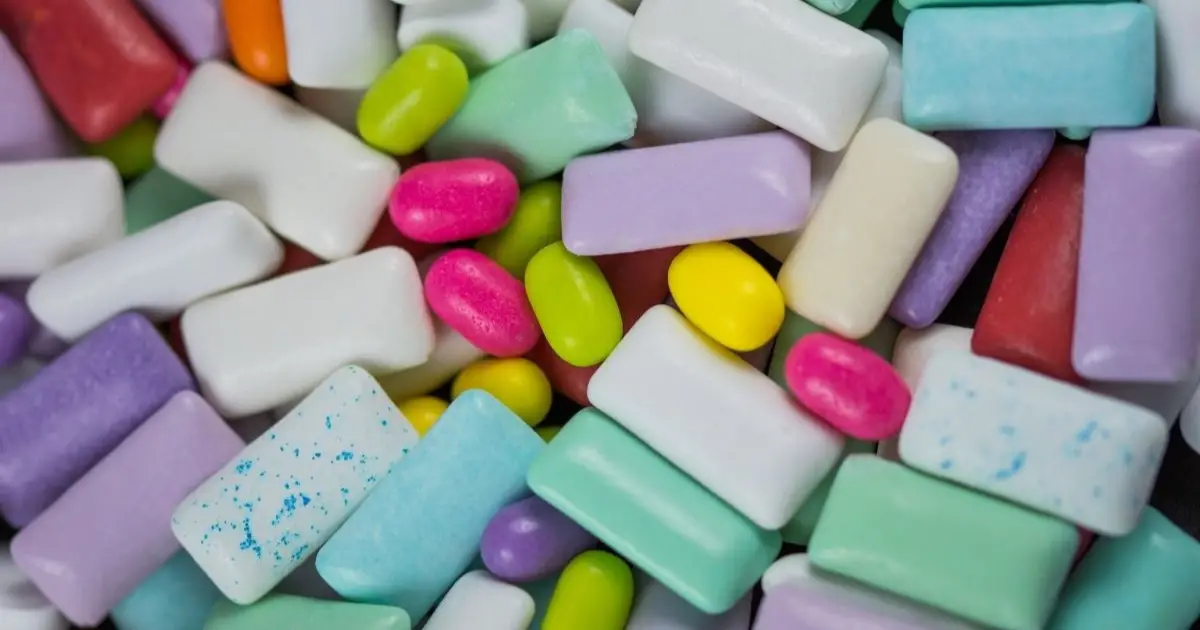April 3rd, 2025
Staff Writer for Wake Up World
Imagine this: every time you pop a piece of chewing gum into your mouth, you’re not just freshening your breath—you’re unleashing a swarm of tiny plastic invaders into your saliva. A groundbreaking pilot study presented at the American Chemical Society (ACS) Spring 2025 meeting has shed light on a startling truth: chewing gum releases microplastics, contributing to the growing accumulation of these microscopic pollutants in our bodies. This isn’t just a quirky science fact—it’s a wake-up call. Let’s dive into what this means for you, how it fits into the broader picture of microplastic exposure, and why it’s time to reconsider that seemingly innocent stick of gum.
The Gum You Chew Is Spilling Plastic
The ACS study, led by Sanjay Mohanty and Lisa Lowe from UCLA, dropped a bombshell: chewing gum releases an average of 100 microplastics per gram, with some pieces spewing up to 600 particles. “For an average chewer consuming 160 to 180 sticks per year, that’s about 30,000 microplastics annually from gum alone,” the researchers estimate [1]. That’s right—every chew could be pumping hundreds of these tiny plastic bits into your saliva, and from there, into your system.
They tested both synthetic and natural gums, chewing each piece for just four minutes. The result? Synthetic gums shed an average of 104 microplastic particles per gram, while natural gums weren’t far behind at 96 per gram—think polyethylene and polystyrene bursting out within the first two minutes from the grinding action of your teeth. Whether you’re a mint or bubblegum fan, the outcome is the same: your gum habit might be a hidden source of plastic pollution inside you.
Microplastics Are Everywhere—And Gum’s Just the Start
Chewing gum isn’t the only culprit. A 2019 study in Environmental Science & Technology found we’re swallowing 39,000 to 52,000 microplastic particles yearly from food and water, ballooning to 121,000 when you factor in what we breathe [2]. That’s 100 to 300 particles daily. Add bottled water to the mix, and you’re gulping an extra 90,000 particles a year compared to tap [2]. Now, toss in the 30,000 from gum, and the numbers get dizzying.
A December 2024 study took it further, spotting over 250,000 microplastics and nanoplastics in saliva after an hour of chewing gum [3]. Nanoplastics—smaller, sneakier cousins of microplastics—can slip deeper into your tissues. “We detected 251,244 particles in just one hour,” the researchers noted, hinting at a plastic flood from something as simple as gum [3]. From seafood to salt to the air we breathe, microplastics are inescapable—and gum is piling on.
What’s This Plastic Doing to Your Health?
Here’s where it gets real. These tiny invaders aren’t just passing through—they might be wreaking havoc. A 2024 study in the New England Journal of Medicine found a chilling link: heart disease patients with microplastics in their carotid arteries were twice as likely to face heart attacks or strokes within three years [4]. “The presence of microplastics doubled the risk,” the researchers warned, tying these particles to clogged arteries and higher death rates [4].
Animal studies paint an even grimmer picture. Mice exposed to microplastics show inflammation, DNA damage, and lower sperm quality [5]. In humans, these plastics have turned up in breast milk, placentas, and organs, sparking fears of long-term harm [6]. Nanoplastics, like those flagged in the gum study, are especially troubling. According to lab research, they can cross cell barriers, potentially triggering cell death or toxic effects [7].
Then there’s the chemical baggage, BPA and phthalates leaching from plastics. These endocrine disruptors are linked to infertility, cancer risks, and developmental issues [8].
The Gum Connection: A Shocking Twist
What makes the gum findings so jaw-dropping? It’s the sheer volume and the unexpected source. Most of us don’t think twice about chewing gum—it’s a habit, a stress reliever, a breath saver. Yet, the ACS study suggests it’s a microplastic delivery system. “Chewing one piece longer could reduce exposure,” Mohanty and Lowe advise, noting that 94% of particles release within eight minutes [1]. Swap out pieces less often, and you might dodge some of the load.
The December 2024 study adds a twist: nanoplastics in the mix. These ultra-tiny particles could slip past your gut, into your bloodstream, and beyond. “Their presence in saliva is a qualitative red flag,” the researchers say, urging more investigation [3]. Suddenly, that gum in your purse feels less innocent.
Why This Matters Now
Microplastics aren’t new—National Geographic calls them “ubiquitous,” from ocean depths to mountain peaks [9]. But the gum revelation hits home. It’s personal. It’s something you choose to put in your mouth every day. And with exposure levels rising—some say we’re ingesting six times more microplastics than in 1990—it’s a ticking clock [10]. Gum isn’t the whole problem, but it’s a piece we can control.
The environmental angle stings too. Discarded gum litters streets and waterways, breaking down into more microplastics. Maria Westerbos of the Plastic Soup Foundation calls it “the biggest oil spill ever” [9]. Your chew could be polluting both you and the planet.
Take Action: Protect Yourself Today
You don’t have to ditch gum—or live in fear of microplastics—to make a difference. Small shifts can cut your exposure and spark change. Here’s how:
- Chew Smarter: Stick to one piece longer instead of popping fresh ones. The ACS study shows most microplastics release early—stretch that chew to eight minutes or more.
- Ditch the Plastic Bottles: Swap bottled water for filtered tap. You’ll slash those 90,000 extra particles a year.
- Go Natural When You Can: While natural gums still shed microplastics, some brands are exploring plastic-free options—hunt them down.
- Spread the Word: Share this with friends. The more we talk, the more pressure builds for companies to rethink gum recipes.
- Support Research: Back calls for human studies. We need hard proof to push for real regulation.
This isn’t about panic—it’s about power. You’ve got the facts: chewing gum spills microplastics into your body, joining a flood of plastic we’re already swimming in. The risks are real, from heart disease to reproductive woes, and the science is catching up fast. So next time you reach for that pack, pause. Chew wisely. Your body—and the planet—will thank you.
Article References
- Mohanty, S., & Lowe, L. “Chewing Gum Can Shed Microplastics into Saliva, Pilot Study Finds.” American Chemical Society, March 2025. https://www.acs.org/pressroom/presspacs/2025/march/chewing-gum-can-shed-microplastics-into-saliva-pilot-study-finds.html
- Cox, K. D., et al. “Human Consumption of Microplastics.” Environmental Science & Technology, 2019. https://pubs.acs.org/doi/10.1021/acs.est.9b01517
- Anonymous. “Cost-Effective Detection of Microplastics Using SERS.” ScienceDirect, December 2024. https://www.sciencedirect.com/science/article/pii/S0304389424035593
- Marfella, R., et al. “Microplastics and Cardiovascular Events.” New England Journal of Medicine, 2024. https://www.nejm.org/doi/full/10.1056/NEJMoa2309822
- Anonymous. “Microplastics Everywhere.” Harvard Medicine Magazine, 2024. https://magazine.hms.harvard.edu/articles/microplastics-everywhere
- Health Effects of Microplastic Exposures.” PMC, 2023. https://pmc.ncbi.nlm.nih.gov/articles/PMC10151227/
- Potential Impact of Nano- and Microplastics.” ScienceDirect, 2024. https://www.sciencedirect.com/science/article/pii/S0013935124004390
- How to Limit Microplastics Dangers.” UCSF News, February 2024. https://www.ucsf.edu/news/2024/02/427161/how-to-limit-microplastics-dangers
- Microplastics Are in Our Bodies. How Much Do They Harm Us? National Geographic, 2024. https://www.nationalgeographic.com/environment/article/microplastics-are-in-our-bodies-how-much-do-they-harm-us
- Humans Now Ingest Six Times More Microplastics Since 1990. Health Policy Watch, 2024. https://healthpolicy-watch.news/humans-now-ingest-six-times-more-microplastics-since-1990/
About the author
John Patterson is an avid writer and researcher who delves into the latest scientific research. With an insatiable curiosity, he translates complex concepts into accessible narratives, allowing readers to embark on a journey of discovery. John bridges the gap between experts and the public through his work, igniting curiosity and inspiring meaningful conversations about scientific breakthroughs.
Most People Will Stay Stuck in 2025—Will You?
Most people will watch the world change and do nothing. But you? I bet you’re a bit like us—you see the writing on the wall. The system isn’t built for freedom, and waiting around for things to get better isn’t a strategy.
What do you know about building wealth outside the system?
If you’ve been looking for a way to break free from the grind and earn in a way that actually aligns with your values, you need to see this.
Inside this FREE masterclass, you’ll discover:
- A proven business model backed by a 50-year-old company
- A plug-and-play system—no chasing, cold messaging, or weird sales tactics
- A way to generate income while focusing on what actually matters
Most people will sit on this and do nothing. The good news? You don’t have to be most people.
Click here to watch now.
If you’ve found value in our articles, we invite you to support the release of our brand-new book, “Gratitude Practices for Kids: A Practical Guide for Adults to Instill a Spirit of Appreciation and Positivity in the Next Generation.“
“Gratitude Practices for Kids” brings together over 25 innovative and accessible practices designed to enhance gratitude in everyday life. This comprehensive guide is backed by 17 scientific studies, ensuring each concept is grounded in research, underscoring our commitment to nurturing growth, emotional intelligence, and positive interactions between adults and children.
We encourage you to opt for the paperback version to celebrate this new release. Dive into its fresh pages away from digital distractions, allowing you to immerse yourself in the transformative practices it offers.
Over recent years, Wake Up World has faced significant online censorship, which has impacted our financial ability to operate. Moving into book publishing represents a strategic step to secure the ongoing funds needed to continue our mission. By purchasing Gratitude for Kids, you help us keep our content free and accessible to everyone, avoiding needing a paywall. With over 8,500 articles published in the last 13 years, we remain dedicated to keeping our valuable content open to all.









